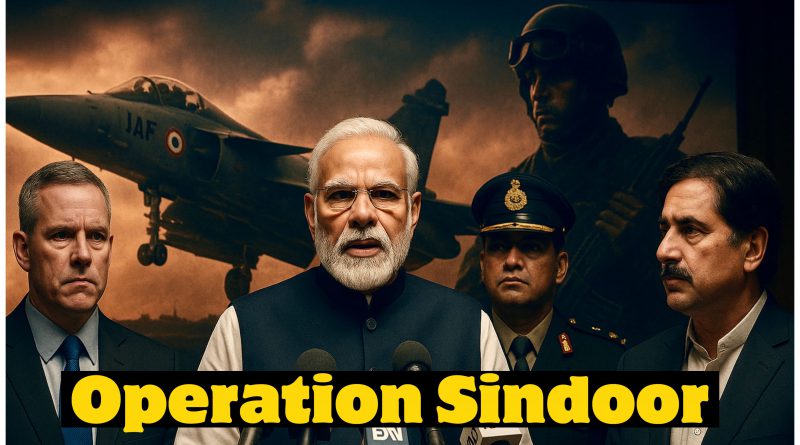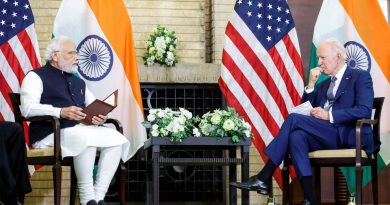ANALYSIS: India’s Operation Sindoor—A New Chapter in Modern Warfare Doctrine
For India, it is a declaration that the era of passive absorption is over. For the world, it’s a test case in modern warfare doctrine.
In a rare public commentary from a senior U.S. military scholar, John Spencer—executive director of the Urban Warfare Institute and coauthor of Understanding Urban Warfare—has described India’s four-day military campaign, Operation Sindoor, as “a decisive victory in modern warfare.” Writing on Wednesday, Spencer called the operation “a model of limited war with clearly defined ends,” asserting that it could redefine how nations respond to state-sponsored terrorism in the nuclear age.
Operation Sindoor was launched by India on May 7, 2025, in response to a deadly terror attack in the tourist town of Pahalgam, Jammu and Kashmir, on April 22. The massacre, which killed 26 Indian civilians, mostly Hindu pilgrims, was claimed by The Resistance Front (TRF), a group widely recognized as a proxy of Pakistan-based Lashkar-e-Taiba (LeT) and backed by Pakistan’s powerful Inter-Services Intelligence (ISI).
Unlike previous Indian responses, this time there was no diplomatic wait-and-see. India struck back with calibrated military action, marking a major departure from its historically cautious approach.
“This was not merely a symbolic gesture,” Spencer wrote. “It was decisive power, clearly applied.”
A New Doctrine Revealed
What makes Operation Sindoor unique, Spencer argued, is the strategic doctrine that underpinned it. While India has not formally declared the operation over, military activity has halted in what officials are calling a “stoppage of firing”—a careful semantic choice that avoids the term “ceasefire” and underscores India’s desire to retain initiative and control.
“The halt in operations is not the end,” Spencer emphasized. “It is a pause. India holds the initiative. If provoked again, it will strike again.”
According to Spencer’s analysis, India achieved four major strategic objectives:
Destroying Terror Infrastructure: Precision strikes targeted key terrorist hubs in Bahawalpur, Muzaffarabad, and Muridke—well beyond the Line of Control.
Demonstrating Military Superiority: India’s ability to launch and defend against retaliatory strikes—including a massive Pakistani drone swarm—highlighted the growing prowess of its domestically developed and internationally supported air defense systems.
Restoring Deterrence: By responding forcefully yet limiting escalation, India signaled to both adversaries and the international community that terror attacks would no longer go unanswered.
Asserting Strategic Independence: India acted without seeking Western mediation or U.N. intervention, a move that signaled its readiness to set and enforce its own red lines.
Four Days That Changed the Region
The timeline of Operation Sindoor was rapid and deliberate:
- May 7: Indian Air Force conducted nine high-precision strikes deep inside Pakistani territory.
- May 8: Pakistan retaliated with a massive swarm drone attack, largely intercepted by Indian air defenses.
- May 9: India escalated with attacks on six Pakistani military airbases and UAV coordination hubs.
- May 10: India declared a halt in operations, maintaining the ability to resume at any moment.
This sequence, Spencer notes, was textbook execution of limited warfare—a campaign designed to achieve political and strategic goals without sliding into open-ended conflict.
“This wasn’t just tactical success,” he wrote. “It was doctrinal execution under live fire.”
Modi Doctrine: “No More Nuclear Blackmail”
The boldness of India’s response also lay in its public messaging. Prime Minister Narendra Modi’s statements during the operation signaled a sharp turn from the past.
“India will not tolerate any nuclear blackmail,” Modi declared. “India will strike precisely and decisively at the terrorist hideouts developing under the cover of nuclear blackmail.”
Spencer interprets this as India laying down a new strategic doctrine—one that separates nuclear deterrence from proxy terrorism, and no longer allows the threat of nuclear escalation to paralyze its counter-terror responses.
Critics of the operation—both domestic and foreign—have raised concerns about potential escalation or destabilization. However, Spencer counters that these critiques overlook the deliberate restraint India displayed.
“India retaliated forcefully but stopped short of full war,” he wrote. “That’s not recklessness—that’s control. It’s the foundation of modern deterrence.”
A Model for Limited War?
Spencer’s praise is significant not just for its content but for its source. As a leading expert on urban warfare and military doctrine, his words will likely be studied in military academies worldwide.
“In an era defined by ‘forever wars’ and cycles of violence without strategic direction, Sindoor stands apart,” Spencer wrote. “It offers a model of limited war with clearly defined ends, matched ways and means, and a state that never relinquished the initiative.”
This could have broader implications for global counter-terrorism strategy. If the international community accepts India’s precedent—that terror attacks emanating from a neighboring state will be treated as acts of war—it could signal a seismic shift in the rules of engagement for statecraft under the nuclear umbrella.
The Next Phase
What happens next remains uncertain. India has not demobilized its forces and retains a high alert status across its western front. Pakistan’s public response has been muted, likely due to the scale of its internal damage and lack of international support. Both countries have avoided crossing nuclear red lines, but the threat of further conflict remains.
Spencer ends his essay with a stark warning—and a call to attention for other democracies facing state-sponsored terrorism:
“India didn’t just respond to an attack. It changed the strategic equation.”
Operation Sindoor, he argues, will not just shape India’s national security policy—it may well influence global strategic thinking about limited war, deterrence, and the role of conventional force in a nuclear world.
For India, it is a declaration that the era of passive absorption is over. For the world, it’s a test case in modern warfare doctrine. And for Pakistan, it’s a reminder that the old playbook may no longer offer protection.
This is not just India’s victory, Spencer concludes. “This is deterrence restored. This is a doctrine revealed. And it should be studied by all nations confronting the scourge of state-sponsored terrorism.”



